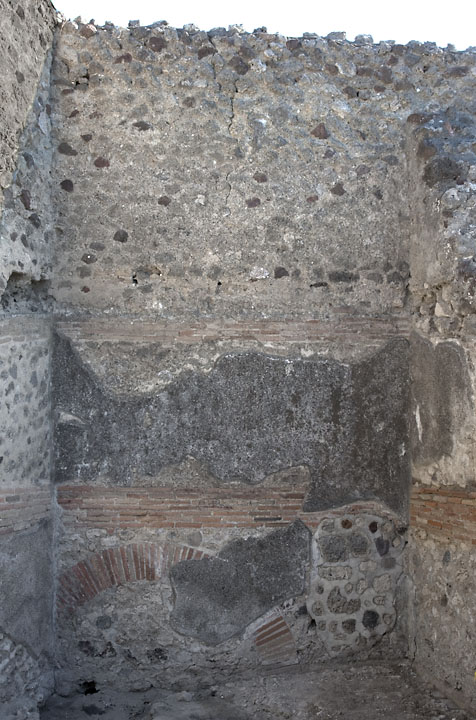East Wall
Description
Henrik Boman
The east wall is built in opus mixtum with opus incertum. One relieving arc in found in the NE corner, and an imprint of the construction of a second floor which beams extended between the N and S walls, found at a height of c. 2.6 m.
During the cleaning of the floor in 2011, no floor level was found in the room. In the SE corner a c. 0.2 m thick layer of that we interpreted as construction debris was found. The debris contained parts of floor material, which first led us to interpret the layer as floor bedding. The layer abuts the E wall.
Breaches made by tunnellers: By the SE corner a breach in the wall is visible. The hole is mended with opus incertum and thick light grey mortar of modern character. The cutting extends partly over the lower rows of brick band, though the not mended with brick.
The east wall is constructed with two brick bands across the wall, what we could see as a continuation of the opus mixtum used in the east wall of room 2. In-between these brick bands; opus incertum with few cruma and lava.
Below the lower brick band, there is a large relieving arc in brick extend over approx. two thirds of the wall. The arc extends c. 1.9 m from the N wall; the exact floor level is difficult to establish, so the height of the arc can only be approximated to c. 1 m. The arc is visible in V 1,1, room 5. The arc is partly covered by a plaster layer, plaster of the same character as the upper layer found on this wall.
The wall above the top brick band is the wall constructed completely in opus incertum, lime stone with some cruma.
The mortar shows the same kind of profile as found in room 2. Here in room 6 the well-defined angled mortar in the joints of the bricks continuing under the preserved plaster, showing that the treatment of mortar is an ancient practice.
The brick quality: The bricks are long (length: 22 — 24 cm, few bricks are shorter; thickness: 3 — 4 cm) and of fairly equal length, in contrast to S and W walls, where we find a greater variety in length between the bricks.
The 2nd floor: Above the top brick band there is an imprint of the ceiling and floor to the second storey. It’s a flat surface with an approx. 0.03 m recess. The beam holes in the N wall correspond to this height, and as we have seen in the comments on the room in general, the beam holes are lacking in the cork model in the National Museum in Naples. The imprints on the E wall do emphasize that a second floor existed in at least this room in the complex. No traces of how access to the second floor was granted, nor I there any signs of circulation between the floor above room 6 to any other areas in the complex V 1.32.
Spoils: One single tufa block is visible, that might indicate a spoil, though the very low frequency of reused material might point to that this single stone is more of an exception, than a rule in the construction principle in this part of the insula.
Plaster: Larger part of the incertum between the brick bands is covered with plaster which extends over the corners to the south and north walls. The plaster is heavily weathered. The plaster has with large particles exposed in the surface, of c. 2-3 mm in size. The lime is fairly white, with a tint of grey, domination the unexposed plaster giving it a whitish tone. No traces of the fine lime coat, color or the decoration of the plaster remains. The underwork for the plaster, yellowish in character, still covers areas of the masonry. It is difficult to separate this plaster traces from the mortar which is of the same tone/hue.
In the lower area, below the brick band, there are faint traces of modern protection plaster
Robbing/Bourbonian hole: By the SE corner a breach in the wall is visible. The hole is mended with opus incertum and thick light grey mortar of modern character. The cutting extends partly over the lower rows of brick band, though the not mended with brick.

